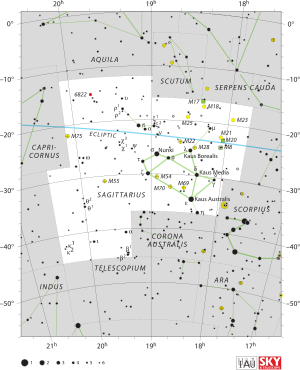Star in the constellation Sagittarius
HD 177765
Location of HD 177765 (circled)
Observation dataEpoch J2000.0[ 1] Equinox J2000.0[ 1]
Constellation
Sagittarius
Right ascension 19h 07m 09.77940s
Declination
−26° 19′ 54.5064″
Apparent magnitude (V)9.15[ 2]
Characteristics
Evolutionary stage
A5 SrEuCr[ 3]
B−V color index
0.45[ 2]
J−H color index
0.071[ 4]
J−K color index
0.055[ 4]
Astrometry Proper motion (μ) RA: -2.063[ 1] mas /yr Dec.: −4.425[ 1] mas /yr Parallax (π)2.5411 ± 0.0186 mas [ 1] Distance 1,284 ± 9 ly pc ) Absolute magnitude (MV )1.55,[ 5] [ 6] Details[ 5] Mass 1.81, 2.2[ 7] M ☉ Radius 2.57 R ☉ Luminosity 18.9, 26.9,[ 6] [ 7] L ☉ Surface gravity (log g )3.79 cgs Temperature 7420, 7002,[ 6] [ 7] K Rotational velocity (v sin i )2.50[ 8] Age 955 Myr Other designations CD −26° 13816,
CPD −26° 6650,
Gaia DR2 6763969142066777344,
HD 177765,
SAO 187692,
PPM 269324,
EPIC 214503319,
TIC 465996299,
TYC 6882-1808-1,
GSC 06882-01808,
2MASS J19070978-2619543, Renson 49550
[ 4] Database references SIMBAD data
HD 177765 is a white-hued star in the southern constellation of Sagittarius . With an apparent magnitude of 9.15, it is too faint to be seen by the naked eye from Earth , but is dimly visible using binoculars .[ 9] Gaia EDR3 parallax measurements.
Description
The star is classified as a rapidly oscillating Ap star (roAp star). It shows super-solar abundances of chromium and strontium as well as many rare-earth elements such as europium and cerium , but is depleted of carbon and nickel .[ 8] pulsate with a low radial velocity amplitude of 7–150 m/s and a period of 23.6 minutes, the latter being the longest out of any known roAp star at the time.[ 7] [ 10]
The precise stellar parameters vary from publication to publication, but the star is considered to be part of a group of evolved roAp stars with long pulsation periods, alongside β CrB A and HD 116114 . The existence of this group implies a systematic shift of rare-earth emission line anomalies as roAp stars age.[ 7]
References
^ a b c d Brown, A. G. A. ; et al. (Gaia collaboration) (2021). "Gaia Early Data Release 3: Summary of the contents and survey properties" . Astronomy & Astrophysics 649 : A1. arXiv :2012.01533 Bibcode :2021A&A...649A...1G . doi :10.1051/0004-6361/202039657 S2CID 227254300 . (Erratum: doi :10.1051/0004-6361/202039657e ) . Gaia EDR3 record for this source at VizieR .^ a b Høg, E.; et al. (February 2000). "The Tycho-2 Catalogue of the 2.5 Million Brightest Stars". Astronomy and Astrophysics . 355 (1): L27 – L30 . Bibcode :2000A&A...355L..27H . ^ Renson, P.; et al. (19 March 2009). "Catalogue of Ap, HgMn and Am stars" . Astronomy & Astrophysics . 498 (3). EDP Sciences: 961– 966. Bibcode :2009A&A...498..961R . doi :10.1051/0004-6361/200810788 ISSN 0004-6361 . Record for this source at VizieR .^ a b c "HD 177765" . SIMBAD Centre de données astronomiques de Strasbourg . Retrieved 30 October 2024 .^ a b Glagolevskij, Yu. V. (2019). "On Properties of Main Sequence Magnetic Stars". Astrophysical Bulletin . 74 (1). Pleiades Publishing Ltd: 66– 79. Bibcode :2019AstBu..74...66G . doi :10.1134/s1990341319010073 . ISSN 1990-3413 . Record for this source at VizieR .^ a b c Scholz, R.-D.; Chojnowski, S. Drew; Hubrig, S. (2019). "Strongly magnetic Ap stars in the Gaia DR2 Hertzsprung-Russell diagram" . Astronomy & Astrophysics . 628 . EDP Sciences: A81. doi :10.1051/0004-6361/201935752 ISSN 0004-6361 . Record for this source at VizieR .^ a b c d e Alentiev, D.; et al. (1 March 2012). "Discovery of the longest period rapidly oscillating Ap star HD 177765" . Monthly Notices of the Royal Astronomical Society: Letters . 421 (1). Oxford University Press (OUP): L82 – L86 . arXiv :1112.4473 Bibcode :2012MNRAS.421L..82A . doi :10.1111/j.1745-3933.2011.01211.x ISSN 1745-3925 . ^ a b Ghazaryan, S; Alecian, G; Hakobyan, A A (19 June 2019). "Statistical analysis of roAp, He-weak, and He-rich stars" . Monthly Notices of the Royal Astronomical Society . 487 (4). Oxford University Press (OUP): 5922– 5931. arXiv :1906.06984 doi :10.1093/mnras/stz1678 ISSN 0035-8711 . Record for this source at VizieR .^ Zarenski, Ed (2004). "Limiting Magnitude in Binoculars" (PDF) . Cloudy Nights. Archived (PDF) from the original on 21 July 2011. Retrieved 6 May 2011 . ^ Daniel L., Holdsworth (18 October 2016). "Detection of new pulsations in the roAp star HD 177765" . Information Bulletin on Variable Stars (6185). Information Bulletin on Variable Stars (IBVS): 1– 5. doi :10.22444/ibvs.6185 ISSN 0374-0676 .
